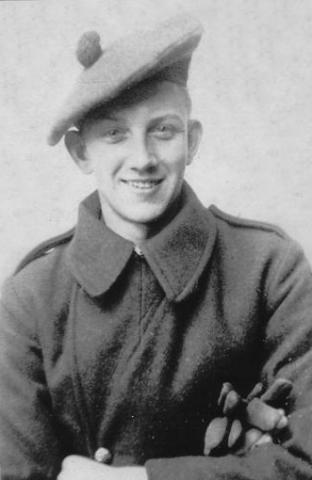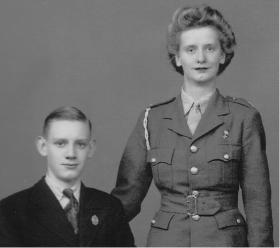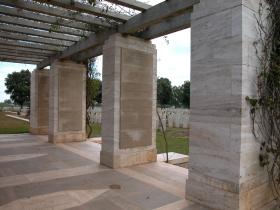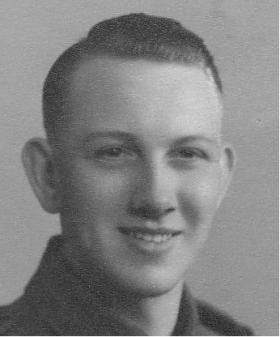Lance Corporal David Black Murdoch, son of James and Mary Murdoch, of Kilmarnock, Ayrshire. He was my father’s elder brother and the uncle I never met. He was killed in November 1942 (aged 20) whilst taking part in a fateful mission with the Parachute Regiment in Tunisia, North Africa. His body was never found. The details of the mission remained largely unknown for many years and I’m certain that neither David’s parents nor, in later years, my father knew the full circumstances of the events surrounding his death. Almost 60 years after this tragic event, I managed to trace one of the last remaining veterans of the mission and he was able to tell me what had happened. However, the story begins with some early childhood memories.
A Soldier’s Medals
As a young boy during the 1970s, I used to visit my grandmother on my father’s side every Saturday morning. She was in her late 70s and lived alone in a small block of flats not far from where I lived in Kilmarnock. I can’t remember the first time that my grandmother showed me the war medals that she had, but I do remember asking to see them during almost every visit. She would often pin them on my jumper and tell me to “march like a soldier” up and down her living room. There were 4 or 5 medals in total and my grandmother referred to 2 of them as “David’s medals”. The others had belonged to my grandfather who had served with the Army in India during WWI (a fact that I was to find out many years later). Thinking back to those times with my grandmother, I believe that she made a point of telling me which medals were David’s so that I would ask the inevitable question – who was David? She would explain that David was my father’s brother and that he had been killed during the war. She would then point to a framed photograph sitting on the mantelpiece of a young man in uniform and say, “That’s him”. I probably asked more questions about David until my grandmother had told me everything I wanted to know (and she wanted to tell me). I also believe that my grandmother got as much pleasure out of telling me about David as I did from wearing his medals and pretending that I was a soldier. Even though I was only aged 7 or 8, I could tell that she was very proud of him.
The Red Devil’s Story
Almost 30 years after those Saturday mornings spent with my grandmother, I took an interest in researching my family history. Thinking about my uncle one day, I wondered if I would be able to trace anyone who knew him, or who had served with him in the Parachute Regiment. My grandmother and my father had both passed away during the intervening years and they had never really spoken much about him. I decided to write to the Letters Page of one of the main daily newspapers in Scotland, asking anyone who knew my uncle to contact me. A few days later, I was delighted to receive a phone call from an elderly gentleman who had served in the same battalion as my uncle and who would be pleased to tell me all he could about that fateful mission in Tunisia.
These are the words of Andrew Young, veteran of the Oudna Airfield mission:
The 2nd Battalion, Parachute Regiment sailed [on troop ships ] from Greenock on 1st November 1942 and my Company (C Company) sailed on the 'Strathmore'. We were bound for Algeria, arriving at Algiers on 12th November 1942. Under the command of Lt. Col. John Frost, the battalion marched approximately 10 miles from Algiers to Maison Blanche and used a school there as a base until Lt. Col. Frost received orders for an operation in Tunisia. Our mission was to destroy German aircraft at Oudna airfield, then to move off to the northwest and join up with the armoured forces of the First Army in the St. Cyprien area.
The Battalion of 530 men boarded approximately 40 American Dakotas at midday on 29 November 1942 and we took off from the airfield at Maison Blanche. We flew over the Atlas Mountains before descending to a height of 600ft in preparation for being dropped near Depienne. Lt. Col. Frost was in the leading Dakota and he dropped first, followed by the rest of the battalion. During the landing one man was killed when his parachute failed to open and a few were injured. Major John Ross led C Company, and we were tasked with securing the area to the south of the drop zone, including the road leading southeast to Zaghouan. We also had to recover the parachutes and weapons containers.
Lt. Buchanan of C Company was tasked with gathering together men who had jumped south of the drop zone and hadn’t yet joined up with the Battalion at Depienne. Once these men had been grouped, they were to evacuate those injured during the landing that were being cared for at a school in Depienne, and then rejoin the rest of the Battalion. As things turned out, Lt. Buchanan and his men were attacked by German forces and, after an exchange of fire during which many paras were wounded, they were forced to surrender, hopelessly outnumbered by the Germans. I remember hearing that after the paras surrendered a German captain handed them over to the Italian Army and they were led to a nearby farmhouse. A jeep carrying a high-ranking German officer approached and he ordered the Italians to shoot the paras. They were lined up against a wall and were about to be shot when an armoured car pulled up. A commander of the German Fallschirmjager got out the car and had an angry discussion with the high-ranking officer. The commander eventually turned to the paras and told them that they were prisoners of war and would be treated as such – he basically saved their lives.
In the early hours of 30 November, C Company lead the battalion on the way to Oudna. We took a route through the hills and the march was very difficult due to the terrain. After approximately 12 miles we stopped for a rest, but it was a cold night and the decision was made to set off again just after 07.00 hours with B Company leading the way this time. By late morning we reached a plain overlooking Oudna airfield and we stopped again whilst Lt. Col. Frost considered his options. He decided that A Company should move towards Oudna and occupy the airfield. However, in the process of carrying out this manoeuvre they came under attack at Sidi Bou Sakouma and suffered casualties. C Company was moved to join up with A Company and assisted to recover the position, with the Germans retreating northwards. Not long after 16.00 hours, C Company took over a farmhouse at Tete Amont de Siphon, whilst another part of the battalion moved to occupy Oudna railway station. When A Company eventually reached Oudna airfield they found that there were no aircraft there to be destroyed.
As we were awaiting further orders at the farmhouse at Tete Amont de Siphon, German tanks approached from the west and attacked us with heavy shell and machine gun fire. Then we came under air attack from two Messerschmitt 109s that appeared on the scene and made several passes at low-level with their machine guns firing. We were ordered not to fire at the fighter planes, as we had to conserve our ammunition. During one of the low-level passes made by the Me 109s, I was shot in the right leg and later captured by a Romanian soldier of the German Fallschirmjager.
In the days that followed after I was captured, the battalion, particularly C Company, suffered heavy casualties as they fought their way to the safety of the British First Army positions at Medjez-El-Bab. In total, 16 officers and 250 NCOs, many of them Scots, were killed, injured or captured during the operation. It had been badly planned and based on inaccurate information that resulted in us being dropped into an area surrounded by German and Italian forces backed with armoured support. The fact that there were no aircraft at Oudna airfield meant that the operation had been completely unnecessary.
From Andrew’s account, we agreed that it was most likely that my uncle had been killed during the armoured tank and air attacks on C Company at Tete Amont de Siphon late in the afternoon of Monday 30 November 1942.
I later obtained records from the Commonwealth War Graves Commission that confirmed that 22 men had been killed on that day from a total of 34 men of the 2nd Battalion plus 1 man of the Royal Army Medical Corps (attached to the 2nd Battalion) who were killed during the five days that the operation lasted. Bodies were recovered and positively identified for only half of all those killed and they were buried in Enfidaville, Massicault and Medjez-El-Bab War Cemeteries. However, within these cemeteries there are a total of 603 individual graves for unidentified members of the Allied forces killed during the African Campaign. Commonly referred to as “unknown soldiers”, it’s possible that my uncle’s body lies within one of these graves. I will never know.
Lance Corporal Murdoch died on 30 November 1942, aged 20 years old. He is now commemorated on the Memorial at Medjez-el-Bab War Cemetery, Tunisia.
From text and photo supplied by Stuart Murdoch
Read More





Latest Comments
There are currently no comments for this content.
Add Comment
In order to add comments you must be registered with ParaData.
If you are currently a ParaData member please login.
If you are not currently a ParaData member but wish to get involved please register.